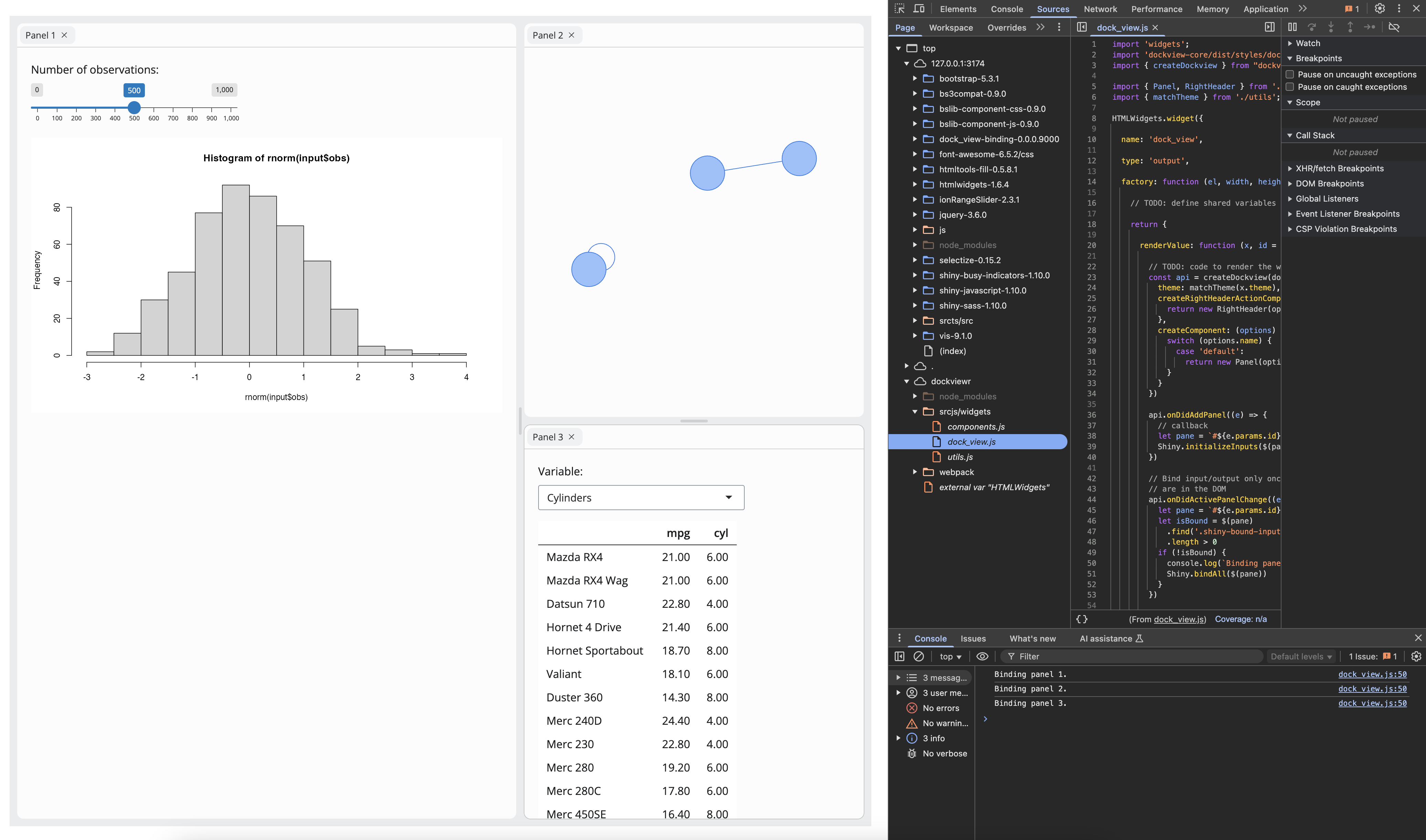
The goal of dockViewR is to provide a layout manager for Shiny apps and interactive R documents. It builds on top of dockview.
The latest version of the dockViewR package can be obtained from CRAN:
# install.packages("pak")
pak::pak("dockViewR")Or, you can install the development version of dockViewR like so:
pak::pak("cynkra/dockViewR")This is a basic example which shows you how spin up a simple dockview app:
library(shiny)
library(bslib)
library(visNetwork)
library(dockViewR)
nodes <- data.frame(id = 1:3)
edges <- data.frame(from = c(1, 2), to = c(1, 3))
ui <- page_fillable(
dockViewOutput("dock")
)
server <- function(input, output, session) {
exportTestValues(
panel_ids = get_panels_ids("dock"),
active_group = get_active_group("dock"),
grid = get_grid("dock")
)
output$dock <- renderDockView({
dock_view(
panels = list(
panel(
id = "1",
title = "Panel 1",
content = tagList(
sliderInput(
"obs",
"Number of observations:",
min = 0,
max = 1000,
value = 500
),
plotOutput("distPlot")
)
),
panel(
id = "2",
title = "Panel 2",
content = tagList(
visNetworkOutput("network")
),
position = list(
referencePanel = "1",
direction = "right"
),
minimumWidth = 500
),
panel(
id = "3",
title = "Panel 3",
content = tagList(
selectInput(
"variable",
"Variable:",
c("Cylinders" = "cyl", "Transmission" = "am", "Gears" = "gear")
),
tableOutput("data")
),
position = list(
referencePanel = "2",
direction = "below"
)
)
),
theme = "replit"
)
})
output$distPlot <- renderPlot({
req(input$obs)
hist(rnorm(input$obs))
})
output$network <- renderVisNetwork({
visNetwork(nodes, edges, width = "100%")
})
output$data <- renderTable(
{
mtcars[, c("mpg", input$variable), drop = FALSE]
},
rownames = TRUE
)
}
shinyApp(ui, server)We welcome contributions! If you’d like to help improve
{dockViewR}, feel free to submit issues, feature requests,
or pull requests.
{dockViewR} is an htmlwidget, an
interactive widget for R, powered by a JS library. To get a minimum
starting kit:
To contribute to this project, you’ll need npm,
node, and the R package {packer} to compile
the JavaScript code. Please follow guide here. When
you are in the project, do the following:
pak::pak("packer")
# Restore JavaScript dependencies in package-lock.json (a bit like the renv.lock)
packer::npm_install()The JS code uses ES6
modules, meaning that you can define a module in a
srcjs/component.js script as follows:
export const blabla = () => {
console.log("Blabla");
}and use it in another script, let’s say ./otherscript.js
like so:
// ./otherscript.js
import { blabla } from './components.js'Whenever you are done with changing the JS script, you have to rebuild it:
# Change the code and then rebundle
packer::bundle("development") # For developement mode
packer::bundle() # For production. Defaut!You may as well bundle for dev using
packer::bundle_dev() when in developer mode and when ready
for production use packer::bundle_prod(). You may also
consider watch() which watches for changes in the
srcjs and rebuilds if necessary, equivalent to
npm run watch.
{dockViewR}, like in
inst/examples/demo, open the viewer on a web browser window
(preferably Chrome as it is used to illustrate the action in this step,
as other browser devtools differ in term of layout).inspect
option on the drop-down menu.Sources tab. Open from the sidepanel
dockviewer/srcjs/widgets/dockview.js script  . Once the
. Once the
dockview.js script is opened on the main panel. You can set
a breakpoint on any line number of the script and reload the page.This package is built on top of the amazing dockview JavaScript library.